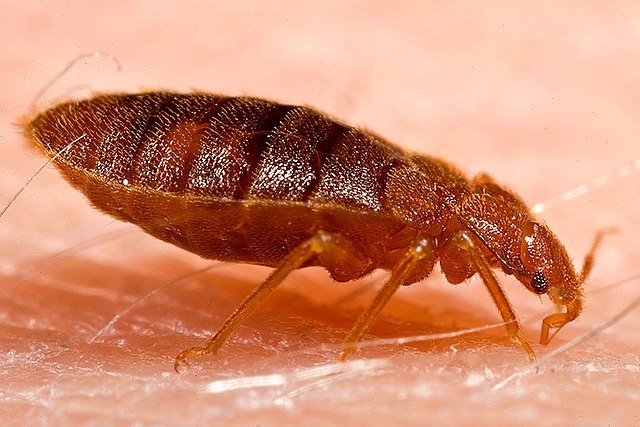House Centipede Lifespan – How Long Do They Really Live?
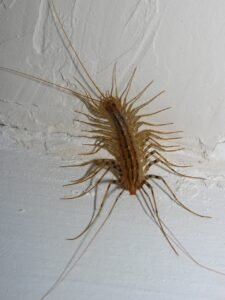 It is not that often, but I sometimes have clients who call us only about the problem of scutigeras (house centipedes). Usually, they are not a big issue, because their population cannot reach very high numbers—something unusual for insects. But sometimes they can become a problem, depending on the conditions in the area we are interested in.
It is not that often, but I sometimes have clients who call us only about the problem of scutigeras (house centipedes). Usually, they are not a big issue, because their population cannot reach very high numbers—something unusual for insects. But sometimes they can become a problem, depending on the conditions in the area we are interested in.
Another weird thing about them is that they live for a very long time. So long, in fact, that their lifecycle can almost be compared to the lifecycle of some animals.
In this article, we will explore the lifespan of house centipedes where they hide, and what helps them survive for so long. We will also look at what science says about their life. Together, we will learn how to repel them naturally, and we will try to bust some common myths.
What Is the Lifespan of a House Centipede?
A house centipede (Scutigera coleoptrata) can live up to 3 to 7 years, depending on its environment and other fasctors. This is unusually long for a common household insects. Most pests like cockroaches or ants live just a few months, but house centipedes can survive for years inside your home if conditions are right.
Quick Answer: How Long Do House Centipedes Live?
| Life Stage | Duration |
|---|---|
| Egg | 1–2 months |
| Juvenile (molts) | 1–3 years (5–10 molts) |
| Adult | 2–4 years |
| Total lifespan | 3–7 years |
Yes, that creepy, fast-moving, centipede in your bathroom could be several years old.
Life Cycle of a House Centipede
House centipedes go through several distinct stages:
1. Eggs
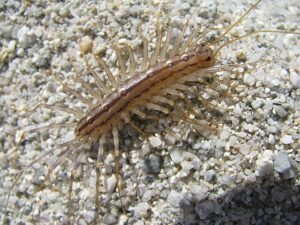
Laid in damp, protected areas, one or two times per year.
Usually in spring or early summer
10 to 60 eggs per clutch
2. Juvenile (Molting Phase)
Hatch in 1–2 months
Go through 5 to 10 molts over 1 to 3 years
Each molt adds more legs and body segments
3. Adult
Fully grown with 15 pairs of legs
Lives another 2 to 4 years
Capable of reproduction
Some individuals may live longer in moist, food-rich environments.
Where Do Long-Lived House Centipedes Hide?
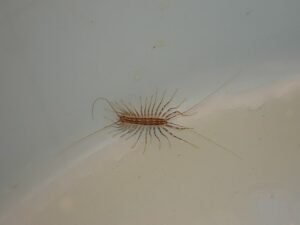 To survive for years, centipedes need stable conditions. They often hide in:
To survive for years, centipedes need stable conditions. They often hide in:
Bathrooms (under sinks, behind toilets)
Basements (cracks, corners, drains)
Closets or storage rooms
Under furniture or appliances
Wall voids or pipe gaps
They avoid daylight and come out mostly at night.
What Helps Them Live Longer?
Humidity: They need moisture to avoid dehydration
Food supply: Feed on spiders, cockroaches, silverfish
Shelter: Hidden, undisturbed areas help them avoid predators
Mild temperature: Prefer indoor climates year-round
In dry or exposed environments, they die off quickly. But in a damp basement with plenty of food? They thrive.
 Do House Centipedes Die After Reproducing?
Do House Centipedes Die After Reproducing?
No. Unlike some insects that die after mating (like flies or moths), house centipedes continue to live and reproduce for years. Females may lay eggs multiple times in their lifetime.
How Do They Compare to Other Indoor Insects?
| Insect | Average Lifespan |
|---|---|
| House Centipede | 3–7 years |
| Silverfish | 2–8 years |
| Cockroach | 6–18 months |
| Spider (indoor) | 1–2 years |
| Fruit fly | 30–50 days |
House centipedes are among the longest-living indoor insects, making them hard to eliminate completely if they find a comfortable home.
Where Are House Centipedes Found? (Global Distribution)
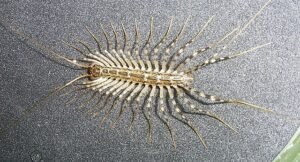 House centipedes originated in the Mediterranean region but they have now spread globally due to human activity travelling and commerce. You can find them in:
House centipedes originated in the Mediterranean region but they have now spread globally due to human activity travelling and commerce. You can find them in:
United States – especially in humid regions like the Southeast and Midwest
Canada – often found in basements and bathrooms during winter
Europe – widespread in homes, especially older buildings
Australia – mostly in coastal cities, though less common than native centipede species
Asia – particularly in temperate climates with high humidity
Their survival indoors makes them more common in cities and urban areas where homes offer stable conditions all year-round.
Natural Predators of House Centipedes
Despite being predators themselves, house centipedes also have enemies. These include:
Spiders – particularly larger species like wolf spiders
Geckos and small lizards – in warmer regions
Birds – only if centipedes are exposed outdoors
Larger centipedes – such as Scolopendra
Humans – the #1 threat through pest control or manual killing
Because they are nocturnal and fast, many of their predators struggle to catch them indoors.
House Centipede vs Scolopendra: Key Differences
The house centipede (Scutigera coleoptrata) and Scolopendra are two very different types of centipedes. The house centipede is small, with a body length of only 2–3 cm, extremely long and thin legs, and it usually lives indoors where it feeds on insects such as cockroaches, ants, and spiders. It is generally harmless to humans. In contrast, Scolopendra centipedes are much larger (10–20 cm), with shorter and stronger legs. They live outdoors under stones, logs, or soil, and they can deliver a painful bite with venom that causes swelling and irritation. Understanding the differences between Scutigera vs Scolopendra is important for correct identification and safe pest control. Βoth the house centipede (Scutigera coleoptrata) and Scolopendra species have 15 pairs of legs (30 in total). The difference is in appearance: house centipedes have extremely long, delicate legs that make them look larger and spider-like, while Scolopendra centipedes have shorter, stronger legs built for speed and delivering painful bites.
DIY Methods to Control and Repel House Centipedes
If you want to reduce or eliminate house centipedes without harsh chemicals, here are effective do-it-yourself strategies:
1. Reduce Humidity
Use dehumidifiers in bathrooms and basements
Ventilate poorly aired spaces
Fix leaking pipes and faucets
2. Seal Entry Points
Caulk baseboards, windows, and pipe openings
Use door sweeps and screens
3. Natural Repellents
Essential oils: Peppermint, tea tree, and eucalyptus
Diatomaceous Earth (DE): Sprinkle in cracks and behind appliances
Cedarwood and citrus: Strong scents that repel many arthropods
4. Traps
Sticky traps (under sinks and along baseboards)
DIY jar traps with bait (like a small amount of sugar water)
5. Remove Hiding Spots
Declutter storage areas
Move furniture from walls
Clean regularly behind appliances
These methods won’t kill every centipede instantly, but over time they make your home far less hospitable.
Common Myths and Misconceptions
"House centipedes are poisonous to humans"
False. They are venomous to their prey, but not harmful to people.
"If you see one, there’s an infestation"
Not necessarily. House centipedes are solitary. One sighting does not mean many.
"They came from the drain"
Wrong. They don’t live in pipes. They hide near them due to humidity, but don’t emerge from drains.
"Killing them is the only way"
Not true. You can use exclusion and deterrents to remove them naturally.
Busting these myths can help reduce unnecessary fear or overreaction.
Scientific Studies on House Centipede Lifespan
Several academic sources confirm the long lifespan of Scutigera coleoptrata:
A study in Entomological Review (Vol. 89) showed that juvenile centipedes may take up to 3 years to reach adulthood, depending on climate and food availability.
A 2004 paper in The Journal of Arachnology highlighted their low reproduction rate and high survivability, especially in controlled indoor environments.
Research from the University of Vienna found that house centipedes exposed to mild, moist conditions lived over 6 years without any artificial intervention.
These findings confirm that their extended lifespan is not anecdotal, but scientifically observed.
Final Thoughts: Should You Worry?
Although house centipedes live a long time, they are not harmful to humans. They don’t damage your home or spread disease. In fact, they help by eating other pests.
Still, if you find them disturbing:
Reduce humidity
Eliminate their food source
Seal entry points
Use traps or safe insecticides
Prevention and environmental control are more effective than brute-force extermination.
FAQ – House Centipede Lifespan
How long does a house centipede live indoors?
Typically 3–5 years, but some may live up to 7 years in the right environment.
Do they die quickly after entering a house?
Not usually. If the environment is dry or food is lacking, yes. But in humid homes, they may thrive for years.
Can they survive winter indoors?
Yes. Indoor centipedes easily survive winter due to stable temperatures.
How many generations can live in one house?
Usually just one or two at a time. House centipedes reproduce slowly and are solitary hunters.
Ready for More Pest Control Insights?
To learn more about flies, ants, cockroaches, bed bugs, and other pests—and how to protect your home or business effectively—visit our main blog page.
Disclaimer
This article is for informational purposes only. Pest control laws and approved chemicals vary by country. For best results and legal safety, we strongly recommend contacting a licensed pest control professional in your local area. Always make sure that the pest control technician is properly certified or licensed, depending on your country’s regulations. It’s important to confirm that they only use approved products and apply them exactly as instructed on the product label. In most places in Europe, UK, or USA, following label directions is not just best practice—it’s the law.

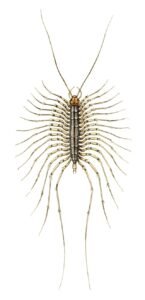 Do House Centipedes Die After Reproducing?
Do House Centipedes Die After Reproducing?